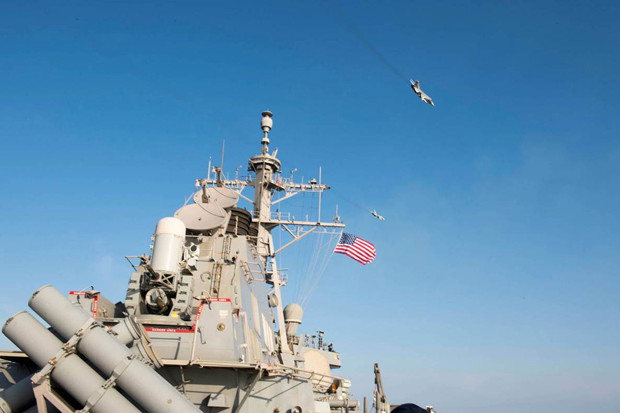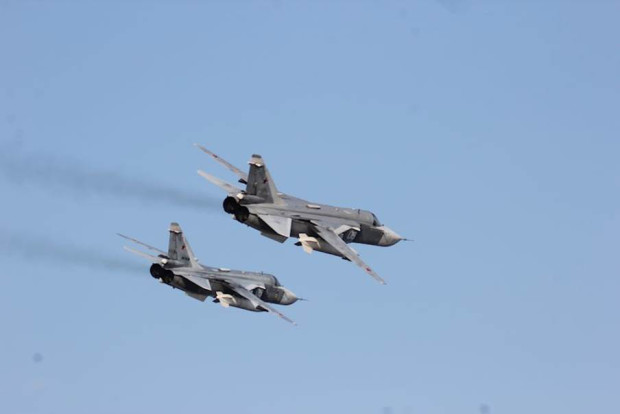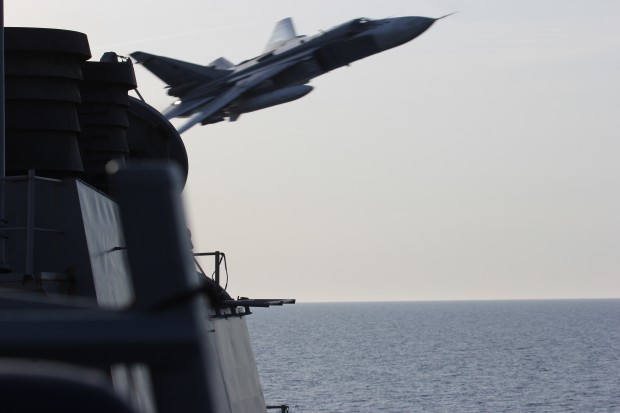Russian jets in repeated ‘aggressive’ passes of US warship

In this Tuesday, April 12, 2016 photo provided by the U.S. Navy, two Russian Sukhoi Su-24 attack aircraft make a low altitude pass by the USS Donald Cook in the Baltic Sea. U.S. officials said the guided-missile destroyer was operating in international waters 70 nautical miles off the Russian enclave of Kaliningrad. AP
WASHINGTON, United States — A Russian military jet came within a few feet of a US destroyer in international waters in the Baltic Sea during a series of “aggressive” overflights, US officials said Wednesday.
Russian aircraft repeatedly buzzed the USS Donald Cook this week, including an incident Tuesday in which a Russian Su-24 flew just 30 feet (nine meters) above the ship in a “simulated attack profile,” the US military’s European Command said.
READ: NATO warns Russia over violation of Turkey airspace | Russian bombers zoom past US warship
“We have deep concerns about the unsafe and unprofessional Russian flight maneuvers,” EUCOM said in a statement.
“These actions have the potential to unnecessarily escalate tensions between countries and could result in a miscalculation.”
Article continues after this advertisementThe incidents come at a time of friction between Moscow and Washington over Russian involvement in conflicts in eastern Ukraine and in Syria, and in an area of eastern Europe that the Kremlin considers its “backyard.”
Article continues after this advertisement
In this Tuesday, April 12, 2016 photo provided by the U.S. Navy, two Russian Sukhoi Su-24 attack aircraft fly near USS Donald Cook in the Baltic Sea. AP
EUCOM released video showing warplanes zooming so close past the Cook that one sailor can be heard saying: “He is below the bridge wing,” meaning the plane was flying lower than the highest point of the ship.
A senior US defense official, speaking on condition of anonymity, said: “This is more aggressive than anything we’ve seen in some time.”
White House spokesman Josh Earnest called the overflights “entirely inconsistent with the professional norms of militaries operating in proximity to each other in international waters and international airspace.”

In this image released by the U.S. Navy, a Russian SU-24 jet makes a close-range and low altitude pass near the USS Donald Cook on Tuesday, April 12, 2016, in the Baltic Sea. The Russian attack planes buzzed the U.S. Navy destroyer multiple times on Monday and Tuesday, at one point coming so close, an estimated 30 feet, that they created wakes in the water around the ship, a U.S. official said Wednesday, April 13. AP
Altitude of 100 feet
The maneuvers began Monday while the destroyer was located about 70 nautical miles from Kaliningrad, a Russian exclave, in international waters.
Two Russian Su-24s flew 20 times past the USS Cook at a distance of less than 1,000 yards (meters) and at an altitude of about 100 feet, the official said.
Then on Tuesday, a Russian Ka-27 Helix anti-submarine helicopter flew seven times around the destroyer, taking photographs as it passed.
Shortly after, two Su-24s roared toward the ship, making 11 close-range and low-altitude passes, including one that was “so low it created wake in the water,” the official said.
The plane was “wings clean,” meaning it was not visibly armed, he added.
US sailors tried multiple times to hail the Russian craft on international frequencies but got no response.
“The Russian aircraft flew in a simulated attack profile and failed to respond to repeated safety advisories in both English and Russian,” EUCOM said.
“USS Donald Cook’s commanding officer deemed several of these maneuvers as unsafe and unprofessional.”
A Polish helicopter had been conducting drills on the destroyer and was refueling during one of the overflights.
“As a safety precaution, flight operations were suspended until the Su-24s departed the area,” EUCOM said.
The Pentagon periodically decries the risky tactics displayed by Russian pilots.
“There have been repeated incidents over the last year where the Russian military, including Russian military aircraft, have come close enough to each other or have come close enough to other air and sea traffic to raise serious safety concerns,” Earnest said.
Exactly two years ago — on April 12, 2014 — a Russian Su-24 made numerous close-range, low-altitude passes near the USS Donald Cook while it was in the Black Sea, in an incident the Pentagon at the time called a “provocative act.”